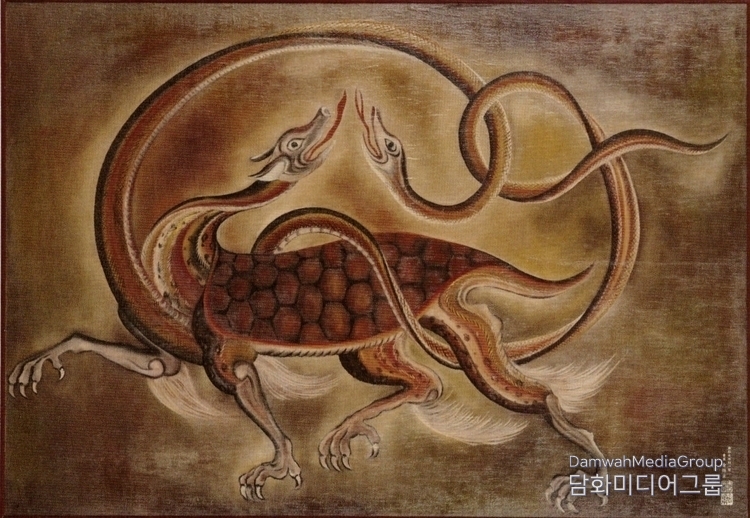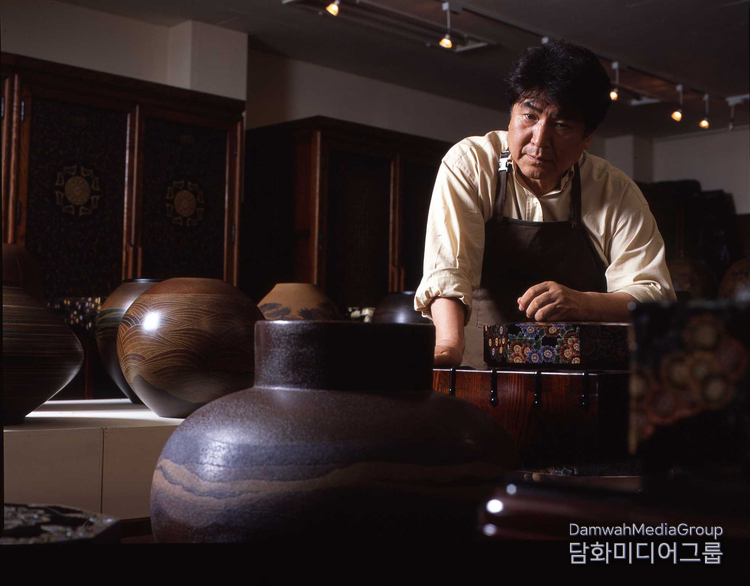By Diplomacy Journal Kayla Lee
Hyeonmudo is one of East Asia's animals of the four cardinal directions, and is a traditional painting mainly found in China and Korea. It symbolizes the north, and is believed to be the deity that rules the northern pavilion of the five divisions of the heavens.
The figure is usually depicted in the form of a turtle and a snake, facing each other and intertwined. This symbolic combination signifies vitality and protection.

The figure is composed of two main elements. First, the turtle is a symbol of longevity and immortality, and is believed to be the link between land and water.
Second, the snake symbolizes change and the flow of life. The combination of these two creatures represents the balance and cycle of nature, on the one hand, and protection from evil forces, on the other.
As one of the most representative subjects of traditional Korean painting, the Hyeonmudo has attracted a lot of attention for its mysterious shape and deep symbolism. Composed of a combination of a turtle and a snake, it is not just a painting, but a cultural heritage that contains the wisdom of our lives and the laws of nature.
Hyeonmudo is the god who rules over the northern pavilion of the heavens, and is usually depicted as a snake entwined with a turtle's body. The combination of these two creatures, the turtle, a symbol of immortality, and the snake, a symbol of change, signifies vitality and protection. In this way, Hyeonmu represents the cycle and harmony of nature and provides an important lesson for human life.

As a harmonizer of the four seasons and the five elements, Hyeonmu presides over winter, which is considered a time of renewal and new beginnings. It is associated with the element of water among the five elements and symbolizes depth and coldness through its black color. More than just a representation of the seasons, it gives us a deeper understanding of life and the cycles of nature.
The origin of Hyeonmudo can be traced back to ancient Chinese mythology and spread throughout East Asia, including Korea. Influenced by Buddhism and Taoism, Hyeonmudo evolved to reflect the cultural characteristics of each region, and its meaning was interpreted in a variety of ways. Today, these traditions continue to influence contemporary art.
More than just a traditional painting, Hyeonmudo reviewing the modern times still convey important messages to modern audiences. It offers deep reflections on harmony with nature, the preciousness of life, and man's place in it. Artist Cheongmok, one of Korea's best lacquer artists, is reinterpreting and reimagining the paintings with a modern twist, making our cultural heritage shine even brighter.
It is not just a beautiful work of art, but an important cultural heritage that embodies the philosophy and worldview of East Asia. Through this work, we can once again realize the importance of the harmony and vitality of nature and find the meaning of our lives in it.
Artist Cheongmok's paintings are mainly made of hemp cloth, raw lacquer, and various colors. These materials are the artist's philosophical and aesthetic endeavor to make the paintings more durable and preserve them for a long time. The artist puts the soul of his art into his Hyeongmudo, delicately depicting each element so that the viewer can experience the mysterious world within the painting.
More than just a painting, his Hyeongmudo is also an important cultural heritage that reflects the philosophy and worldview of East Asia. It plays an important role in understanding the cycle of nature and humanity, life and death, and is a work of art with deep meaning by itself. Even in modern times, its importance and beauty are being rediscovered and appreciated by many people.
Exhibitions and Awards of Cheongmok Kim Hwan-kyung
1961 Joined lacquer woodworking studio
1976 Established Chaehwa Lacquerware Institute (Naedang Studio)
1979 Traveling exchange exhibition of Korean, Japanese and Taiwanese lacquerware artists
1986 The 1st Solo Exhibition of Color Lacquerware (Museum of Contemporary Art)
1989 Won the Grand Prize in the Contemporary Art Exhibition (Vase entry)
1992 Judge of the 22nd National Crafts Competition
1993 Jury member of the 4th Korea Lacquerware Competition International Ishigawa Lacquerware Design Exhibition Silver Prize for Chaewha painting vase (Ishigawa Prize, Japan)
1996 Senior Vice President, Korea Najeon Lacquerware Protection Association
1997 China Lacquerware Exchange Exhibition (National Art Center, Beijing)
1998 Appointed as a member of the cultural product development committee for the 15th National Skill Competition for the Disabled, Najeon lacquerware jury
1999 Invited artist for the International Ishigawa Lacquerware Design Exhibition
Presented a gift of a chrysanthemum pattern work to Queen Elizabeth II of England on April 20 (LG Group)
Made murals and folding screens for Lotte Hotel, Jeju Island
2000 Senior Research Fellow, Hanyang University Traditional Art Center, Invited artist to the World Lacquer Culture Association
2000 Selected as a Korean Millennium Product in the 100 Best Crafts and Cultural Products
2001 UN Educator Award Invitational Exhibition (Lotte Jamsil Folk Art Museum) Special Invitational Exhibition (Museum of Contemporary Art)
2002 Minister of Trade, Industry and Energy Award for Crafts, Member of the Korea Institute of Industrial Technology Assessment
Invited artist to Saint-Germain-en-Laye, France
Grand Prize in the Crafts Division of the 4th Korea National Arts Competition, Bush Presidential Champion Award
2003 Invited exhibition at the US Marine Corps Headquarters to commemorate the 100th anniversary of the US-ROK alliance
2003 Invited to the 1st International NGO Exhibition in Matoguros, Brazil
2004 Designated as Intangible Cultural Property No. 1, Advisory Board Member of the Korean Craft Artists Association
2005 Special exhibition to commemorate the designation of Cheongmok Intangible Cultural Property (Lotte Museum of Art)
2006 Korea Culture and Arts Competition, Craft Division Grand Prize (Vice Prime Minister and Minister of Science and Technology Award)
Honorary Citizenship Certificate of Appreciation, California, U.S.A., and Certificate of Merit, LA Korean Festival, U.S.A.
2008 Gyeonggi-do Skills Competition, Technical Jury Commissioner
2009 Gyeonggi-do Skills Competition (Najeon Chilgi)
2010 Jeonju Asia Pacific Intangible Cultural Heritage Festival
Made a gift for the First Ladies of the G20 Summit
2011 Seoul Intangible Cultural Property Function Preservation Association Exhibition
Chairman of Cheongmok Cultural Foundation (current)
Director of the World Peace Art Exhibition Organizing Committee (current)
2024 Won Ambassador Awards at the Philippines, Peru International Exchange Exhibitions
